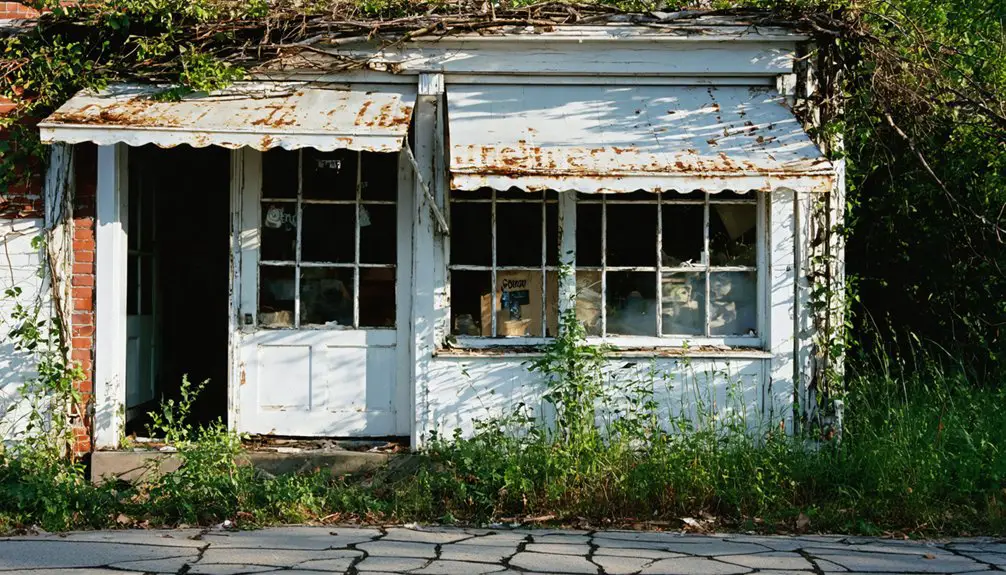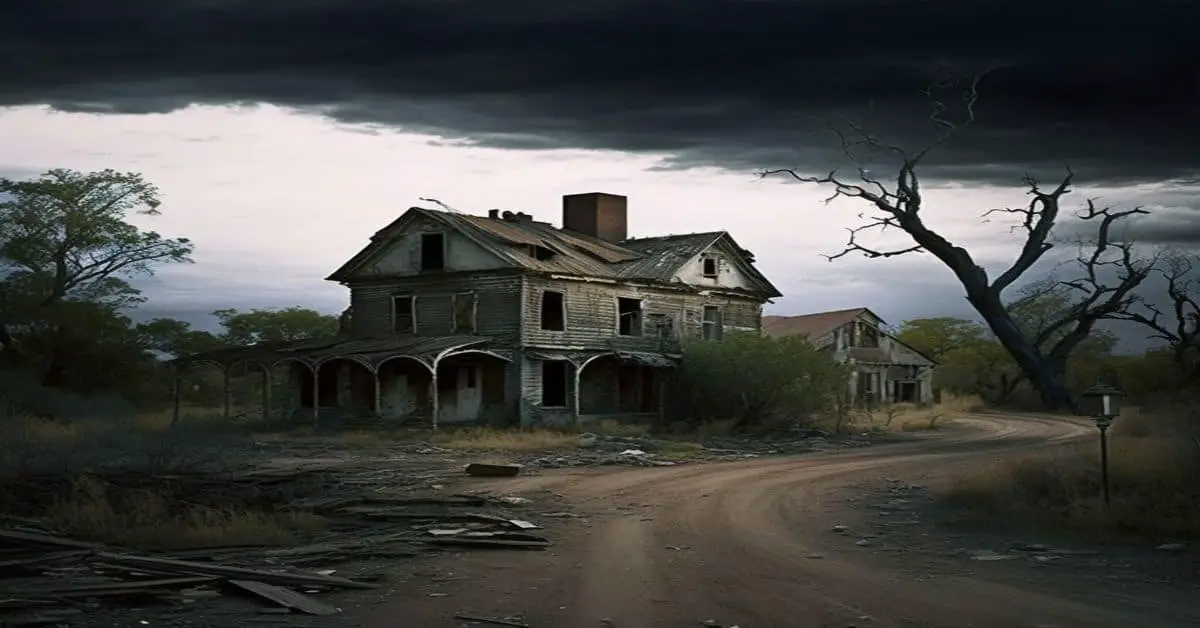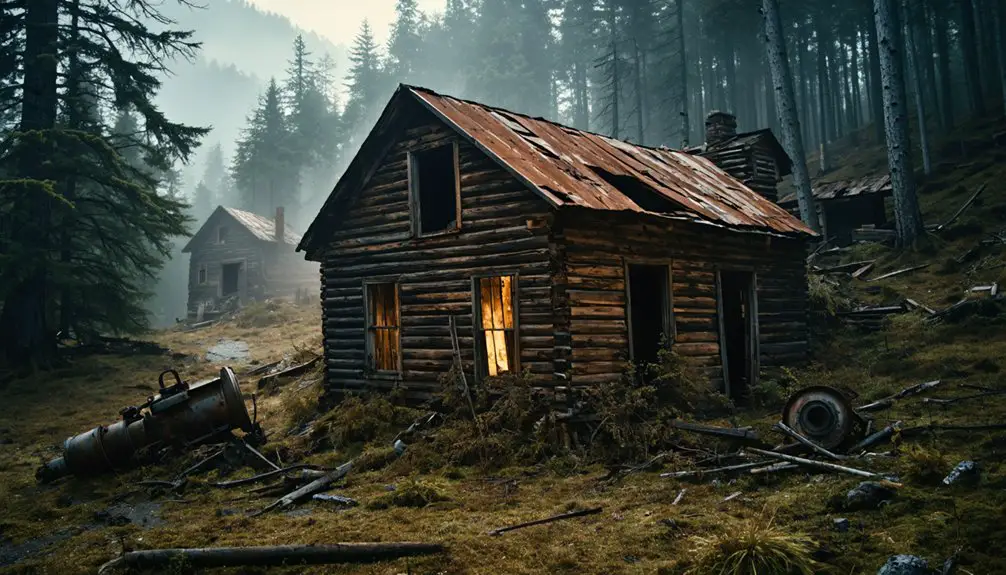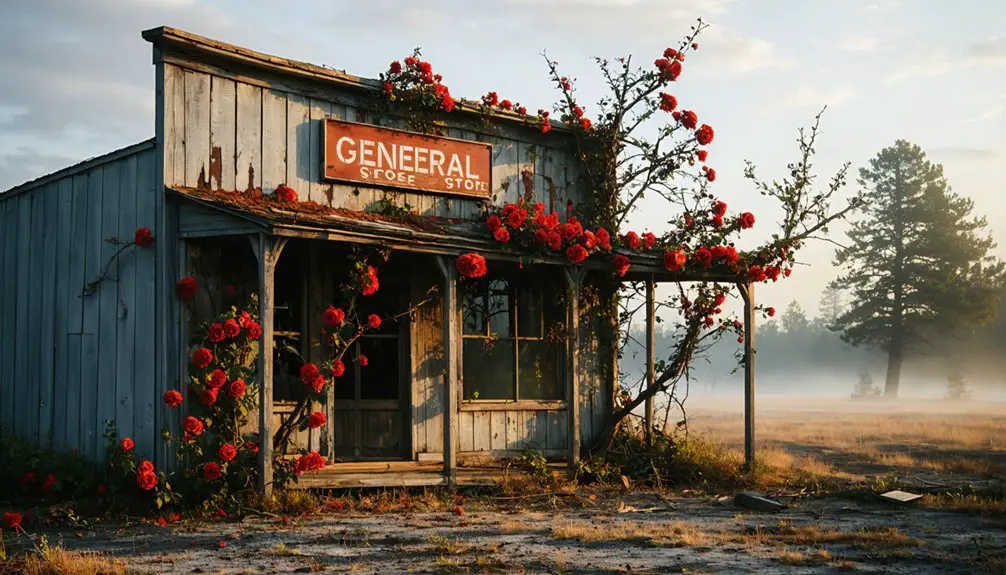You’ll find Wilson’s abandoned remains along Maryland’s North Branch Potomac River, where George Washington Wilson established a thriving lumber town in 1860. This ghost town once bustled with barrel manufacturing and timber operations, supported by railway connections and a historic stone mill complex. By 1974, only one house remained standing, though scattered foundations still mark where this industrious community once stood. The site’s connection to African-American heritage adds another fascinating layer to its story.
Key Takeaways
- Wilson was a lumber town established in 1860 along the North Branch Potomac River by George Washington Wilson.
- The town flourished during the timber boom with sawmills, barrel manufacturing, and railway connections.
- Economic decline began around 1900 when virgin timber supplies were depleted, leading to the town’s abandonment.
- By 1974, only one house remained in Wilson, with empty foundations marking where other buildings once stood.
- The town’s legacy continues through its connection to African-American heritage and the historic Wilson house in Galesville.
Origins and Early Settlement
While Maryland’s landscape is dotted with forgotten settlements, Wilson’s origins can be traced to George Washington Wilson and his father’s strategic land donation around 1860.
You’ll find the founding family’s influence deeply embedded in the town’s establishment, as they chose land along the North Branch Potomac River to maximize transportation potential for their budding timber industry.
The younger Wilson, after serving in the West Virginia Cavalry during the Civil War, returned to establish a thriving barrel component manufacturing operation.
His political career in the Maryland House of Delegates further cemented the family’s local prominence.
The settlement, initially known as Wilson’s Mills, capitalized on the region’s abundant virgin timber resources, transforming the rural landscape into a bustling hub of lumber production and commerce.
The community’s history began when a Quaker Rachel Tyson donated 77 acres of land to African-American brothers in the late 1880s.
The Rise of Wilson’s Mills
The early 1860s marked a defining chapter in Wilson’s Mills‘ ascent as a regional powerhouse.
You’ll find the town’s economic foundations were firmly established along the North Branch Potomac River, where the historic stone mill complex became the heart of local industry. This impressive structure, with origins possibly dating to 1760, stands as a reflection of the area’s rich industrial heritage. Similar to Caroline County’s grist mills, the operation played a vital role in the local agricultural economy.
When the Wilson family took ownership in 1866, they’d expand operations to include barrel stave manufacturing and timber processing. The Maryland Session Laws of 1831 authorized a crucial covered bridge project that would enhance local commerce.
You’ll appreciate how the West Virginia Central & Pittsburg Railway’s arrival and the construction of a covered bridge transformed the settlement into a bustling hub. These transportation arteries didn’t just connect Wilson’s Mills to larger markets – they released the town’s potential as a thriving center of commerce.
Life During the Timber Boom
During the height of Wilson’s timber boom, you’d find a bustling workforce engaged in demanding physical labor from sunrise to sunset.
You’d witness skilled workers felling trees while others constructed logging roads or operated the steam-powered sawmills near the North Branch Potomac River.
Community dynamics centered around the timber industry, with families passing down their trades through generations.
You’d see children learning the business early, while their parents worked long hours in all weather conditions. Much like Ken Wilson, who started working at seven helping on his father’s lumber truck, these young workers gained invaluable early experience.
The labor challenges were significant – from managing teams of oxen and horses hauling heavy logs to fueling steam engines and maintaining equipment.
Despite the advent of mechanical sawmills, most work remained hands-on, requiring both strength and skill.
Mill houses dotted the landscape, serving as the backbone of Wilson’s close-knit, hardworking community.
The Path to Abandonment
As virgin timber supplies near Wilson dwindled by 1900, you’d witness the town’s slow descent into abandonment. The lumber industry’s collapse exposed Wilson’s economic vulnerability, with stave and barrel manufacturing soon following suit.
Without its primary resource, the town couldn’t sustain itself.
You’d see the impact of resource depletion ripple through the community as the West Virginia Central & Pittsburgh Railway reduced its service. This isolation, combined with nearby mine closures, severed vital trade connections.
With no alternative industries emerging to replace timber-based commerce, residents began seeking opportunities elsewhere. The town’s position along the rocky North Branch Potomac River offered little advantage for redevelopment. Today, Wilson straddles both states with modern coal mining operations visible in the distance.
Legacy and Remaining Traces
Today you’ll find scattered remnants of Wilson’s once-vibrant lumber town scattered across Maryland’s rocky Potomac riverbank. By 1974, only a single house stood as evidence to this forgotten settlement, with empty foundations and lone chimneys marking where homes and businesses once thrived.
While Wilson’s physical traces have largely vanished, its cultural significance lives on through unexpected connections. In Galesville, the Wilson house – owned by a formerly enslaved family who purchased land in 1870 – became a cornerstone of African-American heritage.
Their baseball field, home to the Galesville Hot Sox Negro league team, created an essential community gathering space during segregation. Though historical preservation of Wilson itself remains minimal, these lasting legacies remind us how seemingly lost places can shape communities in profound and surprising ways.
Frequently Asked Questions
Were There Any Notable Crimes or Lawlessness Incidents in Wilson’s History?
You won’t find significant crime statistics or major law enforcement incidents in Wilson’s recorded history, though recent years have seen occasional break-ins and drug-related crimes in its abandoned buildings.
What Types of Wildlife Inhabited the Wilson Area After Abandonment?
You’d find remarkable wildlife diversity in the abandoned area, including beavers engineering wetland habitats, osprey nesting near shipwrecks, diverse amphibians in water-filled depressions, and mammals adapting to rewilded structures.
Did Any Paranormal Activity Reports Emerge From the Abandoned Wilson Site?
You won’t find documented ghost sightings or official paranormal reports from this location. Unlike other haunted locations in Maryland, there’s no verified evidence of supernatural activity at this abandoned settlement.
What Happened to the Cemetery and Burial Grounds of Wilson’s Residents?
You’ll find the cemetery’s history reflects poor preservation, with over 4,000 burial sites covered by debris and soil. The city removed headstones in 1994, leaving only one central monument to mark ancestral graves.
Were There Any Attempts to Revive or Repopulate Wilson After 1900?
You won’t find evidence of successful revival efforts after 1900. The town’s population steadily declined following timber depletion, and by 1974 only one house remained standing in Wilson.
References
- https://rsftripreporter.net/ghost-towns-of-the-upper-potomac/
- https://abandonedonline.net/location/wilson/
- https://en.wikipedia.org/wiki/Wilson_(ghost_town)
- https://www.aacounty.org/planning-and-zoning/historic-preservation-planning/local-history-resources/wilson-house
- https://www.geotab.com/ghost-towns/
- https://kids.kiddle.co/Wilson_(ghost_town)
- https://www.cbsnews.com/baltimore/news/wilsontown-maryland-quakers-freed-odenton-anne-arundel/
- https://kentcountyhistory.org/history/
- https://apps.mht.maryland.gov/medusa/PDF/Harford/HA-11.pdf
- http://www.heritage.umd.edu/chrsweb/associatedprojects/chidesterreport/chapter v.htm



